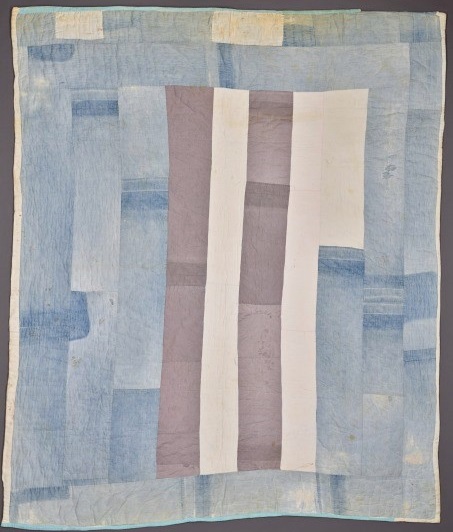America Will Be!: Surveying the Contemporary Landscape, the DMA’s new free exhibition on view April 6 through October 6, 2019, ends with “The Home.” One of six thematic galleries, “The Home” is the last in the exhibition and features one object in particular whose form is at once familiar and comforting—a worn and humble quilt, Amelia Bennett’s Bars and Strips. The quilt is included in the exhibition after a recent acquisition of seven artworks from the Souls Grown Deep Foundation, which collects and advocates for the work of self-taught African American artists from the Deep South. Amelia Bennett is one of over 100 women collectively referred to as the Gee’s Bend Quiltmakers. These women are part of a rich tradition of quilt making in their shared community in Alabama, dating as far back as the mid-19th century. The story of how these quilts, made for intimate spaces of the home, have ended up on the walls of major museums asks viewers to consider the roles race and class play in the formation of art history.

© Souls Grown Deep Foundation
The Souls Grown Deep Foundation advocates for works such as Bennett’s quilt to be considered within our modernist paintings in the art historical canon. Incorporating what is considered craft or folk art into the larger framework of high art begins to historically correct for the absence of women, and more specifically, women of color, in the mainstream narrative of US art production; however, the foundation’s current efforts in advocating for these artists demand a renewed consideration of the work on its own terms, necessitating a critical look at these objects’ pasts. Historical attempts to introduce the quilts of Gee’s Bend to the larger art world inadvertently reinforced harmful understandings about why we should value the art production of black women living in remote parts of the country.
In attempts to make them legible to art audiences, the quilts were introduced as reflecting the aesthetics of modernist art movements such as Abstract Expressionism. Valuing these quilts only as approximations of abstract painting diminishes the inherent creativity and worth of the quilts themselves when, in fact, the Gee’s Bend quilts are not derivative but a historical part of Abstract Expressionism’s development. Founders of Abstract Expressionism originally drew from sources such as folk and classical art to legitimize their art movement as one that spoke to a universal humanity. Barnett Newman, Robert Murray, and Roy Lichtenstein looked to quilts to develop a sense of home-grown American art aesthetics and identity unique to the nation. Discussing the quilts as attempts at modernist painting erases this history and does not validate their status as art objects produced by women of color without connecting them to a formal, masculine, and traditionally accepted art movement.
The second popular reading of the quilts was developed by their founder William Arnett. He believed that the quilts and other assemblage works by Souls Grown Deep artists actually embodied a complex and private system of communication among black community members in the South. Other related readings connected the colors and patterns in Gee’s Bend quilts to those used in textiles in West Africa. Maude Southwell Wahlman, an African and African American art historian, believed these techniques were passed down from generation to generation, so that contemporary quilters were embedding codes into their works that even they no longer knew the significance of; however, textile historian Amelia Peck quickly sets straight that these readings, “about most African Americans being unaware of the symbols and signs in their quilts makes the concept both paternalistic and suspect.” The Souls Grown Deep Foundation grapples with these histories of interpretation, including its own past, in order to make sense of the artists’ work for our contemporary moment.
The quilts of Gee’s Bend are compelling on their own, unrelated to what these interpretations impose on them. Bennett’s Bars and Strips was made to captivate the viewer with its block patchwork composition and gradations of blues and grays. It wears its history, its over 90 years of age. The small tears, discolorations, patches, wrinkles, and uneven wear speak to the former lives of the fabric pieces, when they covered legs, soaked up sweat, and faded in the sun. The quilt moves beyond holding our aesthetic attention. Bennett’s work visually embodies the hard labor of her family and community members, and the poverty in their community that necessitated recycling every small bit of cloth. Its colors and patterns speak not to Mark Rothko’s color fields or to lost secret codes, but to the rich history of a multi-generational art practice and the ability to glean creativity and beauty out of hardship. While America Will Be! ends with “The Home,” contemporary understandings of US art history should begin in the domestic and creative sites of women and people of color so long overlooked.

Read more about the Gee’s Bend Quilts as contemporary art objects:
Peck, Amelia. “Quilt/Art: Deconstructing the Gee’s Bend Quilt Phenomenon.” In My Soul Has Grown Deep: Black Art from the American South, edited by Kamilah Foreman. New Haven: Yale University Press, 2018: 53-91.
Kimberly Yu is the McDermott Intern for Contemporary Art at the DMA.






